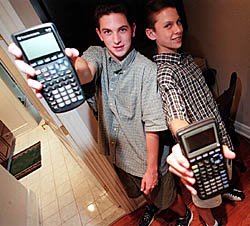
|
 |
| |
September 2, 1999 |
| Powerful Calculators Throw Teachers a New Curve |
| Students Reprogram Powerful Math Aids to Play Games and Maybe Get a Leg Up on the SAT - By JENNIFER 8. LEE |
| |
| Like hundreds of thousands of other high school students, Greg Myers, 16, began using a graphing calculator in freshman algebra. Graphing calculators, which bear little resemblance to their 1970's ancestors, are sophisticated devices that can run small computer programs and draw the graph represented by complex equations in an instant. In the last few years, they have become mandatory in many high school math classes and can be used on the SAT and advanced placement exams and other standardized tests. |
| |
 "I use graphing calculators all the time, and am a big enthusiast," Greg said. "In my math class last year, I was known as the expert on graphing calculators." "I use graphing calculators all the time, and am a big enthusiast," Greg said. "In my math class last year, I was known as the expert on graphing calculators."
And like many of his high school peers, Greg has found another use for his calculator, a Texas Instruments TI-83. He has gone into business with his brother, Douglas, 17, writing 20 programs that can be fed into graphing calculators to help solve math problems in the SAT exam and SAT II subject tests.
Douglas Myers, left, and his brother, Greg, have written calculator programs that they say will help with SAT tests. |
| |
| "There is no work involved, you just run the program, plug in the known values, and watch your answers appear," says their Web site (www.highersat.com). The brothers are charging $40 for the programs and guarantee that a student's score will rise by 90 points or more. They said they had not had many takers so far. "Right now, we don't take credit cards," Greg said. "It's got to be check, money order or cash. If things get better, we'll probably start accepting credit cards."
Graphing calculators, which cost around $140, are lauded as the greatest innovation in math classrooms in a generation. Proponents say they lift students' confidence, cultivate their analytical adeptness and make mathematics more tangible. But they have also given students new ways to one-up their teachers and the rules. In response, adults have been forced to develop more sophisticated defenses, tests and regulations. Even while they solve difficult problems, graphing calculators have changed the political equation in the classroom.
Greg contends that his and his brother's programs are not cheating. "Cheating is violating regulations unfairly, but our programs do not violate any regulations." Graphing calculator programs are allowed on College Board examinations. Teachers and test administrators say that the arrival of the calculators allow questions to focus more on problem solving, rather than plug-and-chug calculations, and they are skeptical about claims like the Myers brothers'. |
| |
| The two brothers, who attend Princeton Day School, a private school in Princeton, N.J., anticipate a potentially large market for their wares.
Texas Instruments, which dominates the market for high school graphing calculators, estimates that one-quarter to one-half of all high school math students use graphing calculators and that nearly all of them take the SAT I or SAT II. Hewlett-Packard and Casio have a small share of that market.
"These calculators are handheld computers," said Ellen Hook of Norfolk, Va., who has been teaching high school math for 20 years. "They are marvelous. I can do more mathematics better now than I could 15 years ago. Students' critical thinking skills have changed."
Since their introduction in high schools in the early 1990's, graphing calculators have not only pushed students to expand their mathematical reasoning skills but have also fired up their ingenuity.
Charles Sullivan, a 15-year-old student in Georgetown, Tex., used his Texas Instruments calculator to explore the structure of triangles in trigonometry. The algorithms that computed the intricate relations among cosines, angles and lengths gave him an appreciation for the elegance of math and programming. "You can understand how math comes together more," Sullivan said.
But once Charles is convinced that he understands the math, he simply programs his calculator to do the number-crunching for him. "In math class a lot of the homework is routine, you can do it over and over," he said. "If you know it, you can whip out your calculator, write a program and press Enter a couple of times, and you've got your answer."
The graphing calculator is also Charles's weapon against boredom. He keeps a number of games, like Space Invaders and Tetris, on his calculator, and he has no qualms about playing them in class.
Texas Instrument calculators are essentially Nintendo Game Boys in disguise -- they have a nearly identical microprocessor with less obtrusive packaging. "If some kid brought a Game Boy into class, they'd be sent to the office, whereas a graphing calculator can't get you into trouble," Charles said.
There are now hundreds of games, including Pac-Man and the Legend of Zelda and versions of Mario Brothers, available for graphing calculators. The majority of them are written by students and are available free for downloading on www.ticalc.com and other sites on the Internet. The games can then be transferred to the calculators through a cable to the calculators. Students can also exchange games with each other by connecting their calculators, and it is possible to make the calculators communicate through infrared signals.
Games became popular only after the Texas Instruments assembly language, the most basic level of programming, became commonly available. But that itself came about because of student ingenuity at work.
Originally, Texas Instruments had decided not to release the assembly language, which provides the most efficient building blocks for programming. "We had internal bets to see if people could figure out the assembly language," said Richard Schaar, a vice president at Texas Instruments. "But then kids figured it out their own. They reverse-engineered the assembly language." The engineers at Texas Instruments were impressed.
Students like to play games on the graphing calculators because they blend into an educational setting. But teachers are not easily fooled. "If the kids are moving the keys real fast on the calculator, you know something's up," said Sam Powell, a math and computer teacher from Middlebury, Ind. "Usually you walk around the class and quietly ask the kid not to play on the calculator, and they usually comply."
Teachers are also becoming aware of the power of calculators on tests. Many teachers make students erase programs from their calculators before exams, and some standardized tests make clear calculator memories mandatory. But a number of utilities exist that can make it appear that a calculator's memory is clear even though it still has programs in memory. The utilities either throw up a screen that mimics the real Mem Clear display, or they can make the list of programs disappear while leaving them accessible to those who know the specific names of the programs.
Calculators have even had educational impacts beyond quantitative subjects. A few years ago, French and history teachers approached Ms. Hook because they were curious about why students were using their graphing calculators during their tests. Mrs. Hook quickly deduced that students were storing information for the tests as text in the memory of the calculator. Now calculators are forbidden for such tests.
Teachers are wising up. "A teacher that is smart enough to use technology is smart enough to know what students are doing," Ms. Hook said. "Physically clear the calculator yourself. Don't just accept a blank screen." At her school, some teachers get together after school to have a calculator-clearing session. |
| |
| Fancy calculators draw wide praise but raise some ethical questions. |
| |
| Rather than fighting students' programs, some teachers are redesigning their exams to take the programs into account. "My level of sophistication has changed in what we ask the kids to do," Ms. Hook said. "I never ask a question that just depends on calculator use. You want to mix the question with analysis." Occasionally she will even distribute programs for the graphing calculators for students to use on tests.
The Educational Testing Service, which offers the SAT, says students who use calculators on the SAT I, the general college admission test, do slightly better than students who do not. But that is because those students can avoid computational errors, not because of the design of the test, said Kevin Gonzalez, a spokesman for the service. Calculator programs like the Myers brothers' will not help on the tests, the testing service said. "There is nothing about the test that is geared to the calculator," Gonzalez said. "This is mathematical reasoning -- it's not one plus one equal two. It's not a test of what you know, it's how you apply what you know."
Then what about the Myers brothers' programs? Douglas Myers said he had raised his score on a SAT math subject test by 90 points, to 700, in part because he used his programs -- only about a third of them were available at the time. On his first try, Greg scored a 640 on a similar test, but he said he planned to use the graphing calculator again. "There are a lot of common formulas and stuff that you have to use," Greg said. "To have programs to do them faster without mistakes for a long problem really helps, especially the speed thing."
Others are skeptical about the brothers' contentions. "Their claims are logically implausible," said Robert Schaeffer, public education director of Fairtest, a nonprofit testing watchdog organization based in Cambridge, Mass. "It's hard to believe that it would be a significant boost to anybody's scores since so few questions involve calculators of any form. The basic formulas are supplied on the test booklets." |
| |
 |
But he gives the brothers credit for their ingenuity. "It's creative marketing," he said. "And it's creative programming to get the power of that handheld to get that kind of information."
Other students have used graphing calculators to show their flair for engineering. Charles Sullivan is constructing a pair of infrared links based on designs he found on the Internet. He plans to keeping lending an infrared accessory to friends so their calculators can communicate using invisible signals. "During the test, I can be giving answers across the room or getting answers across the room," he said.
Sami Khawam, 19, an engineering student at the University of Edinburgh in Scotland, began the design for the infrared accessory for the Texas Instrument calculators while he was in high school. The infrared link can act as a universal remote control that can send commands to televisions and VCR's. "The calculator is also able to receive I.R. data, thus making it controllable by any remote control device," Khawam said.
The infrared devices have raised some eyebrows, but some doubt that they can be used effectively to cheat. "The concern with calculators is that there are some schools who are afraid that students can use this I.R. feature to cheat on exams," said Whit Hickman, a technical sales manager at Hewlett-Packard. "The reality of that happening is that you have to be within two inches of each other." Nonetheless, in response to the criticism, Hewlett-Packard pulled the infrared feature from one of its latest models of graphing calculators. |
| Laura Pedrick for The New York Times |
| Charles Sullivan, 15, of Georgetown, Tex., uses his graphing calculator for tedious calculations and to break up tedium with games. |
The cat-and-mouse game between teachers and students will probably accelerate as calculators grow even more sophisticated. The latest generation of Texas Instrument calculators now have what is known as flash memory, which gives the calculator the flexibility to offer functions beyond mathematics. A calculator could, for example, act as a handheld digital organizer.
"I can see the handheld devices getting pretty close to the Apple IIe functionality from the early 1980's," predicted Jim Kaput, a professor at the University of Massachusetts at Dartmouth.
Ms. Hook said the increasing power of calculators was a positive trend.
The more power in the hands of her students, the better, she said. "I think that is exactly what we need for this generation," she explained. "They need to be in control."
|
| |
Related Sites
These sites are not part of The New York Times on the Web, and The Times has no control over their content or availability.
|
|
| |
|
|
|


